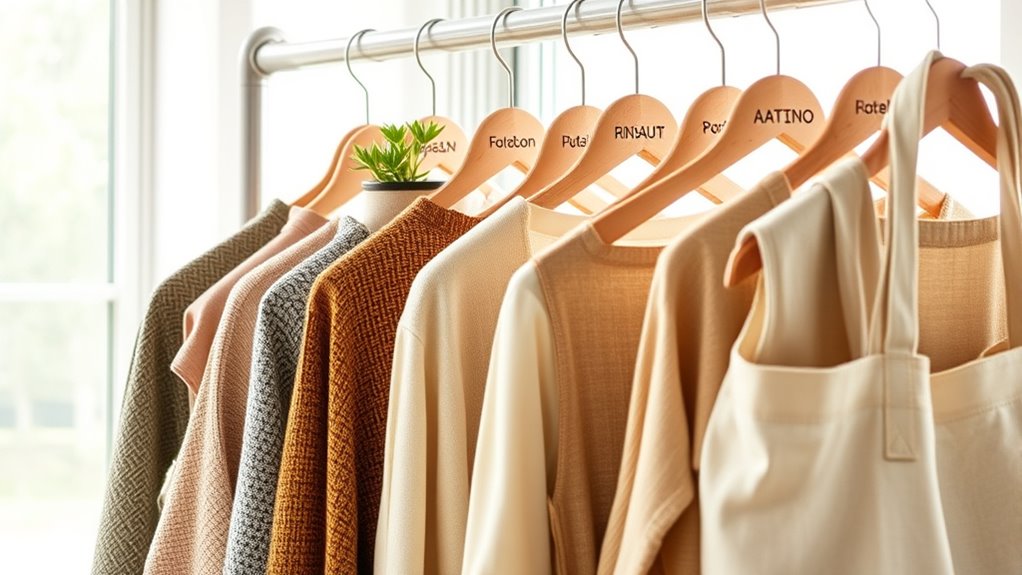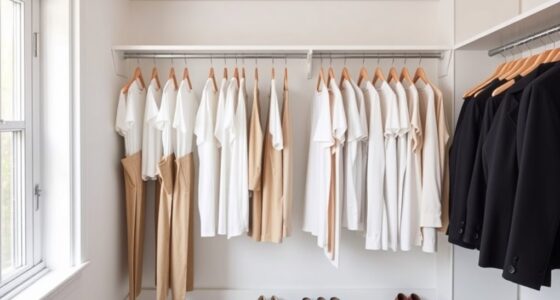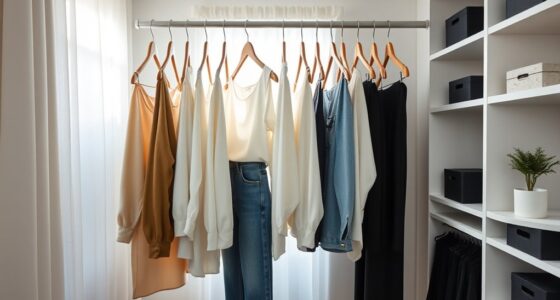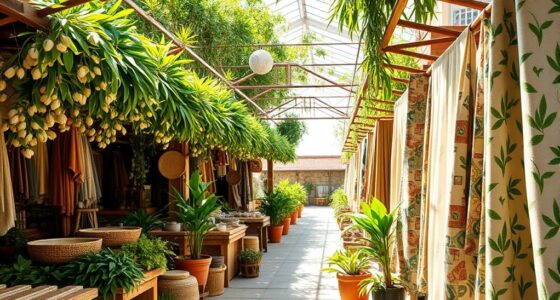To build a sustainable and ethical wardrobe, focus on choosing high-quality, timeless pieces made from eco-friendly materials like organic cotton, hemp, and recycled fabrics. Prioritize supporting brands with transparent supply chains, fair labor practices, and certification labels. Invest in versatile essentials that last, care for your clothes properly, and explore secondhand options to extend your wardrobe’s life. By making conscious choices, you help reduce waste and support a fairer fashion industry—discover more ways to style ethically as you continue.
Key Takeaways
- Prioritize versatile, timeless pieces made from eco-friendly fabrics to create a durable, long-lasting wardrobe.
- Choose brands with transparent supply chains and ethical certifications to ensure fair labor practices.
- Support secondhand, vintage, and local artisans to promote sustainable, circular fashion practices.
- Properly care for clothes to extend their lifespan and reduce unnecessary waste.
- Invest in high-quality garments that maintain their appearance and function over time, reducing overall consumption.
Understanding the Principles of Sustainable Fashion
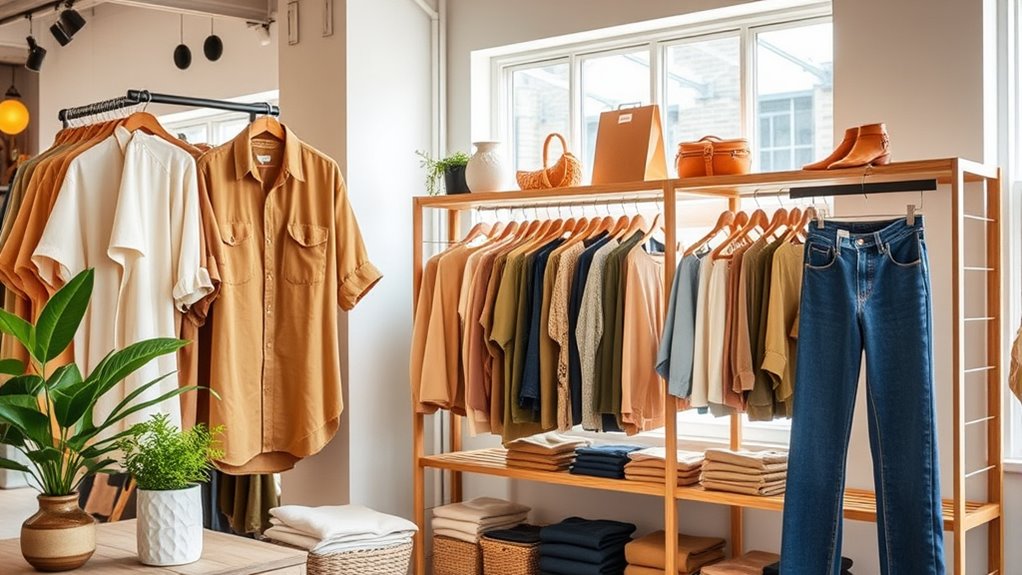
What exactly are the core principles that define sustainable fashion? At its heart, sustainable fashion emphasizes reducing environmental impact through responsible production and consumption. It encourages you to prioritize quality over quantity, investing in pieces that last instead of fast fashion’s disposable trends. Ethical labor practices are essential, ensuring workers are paid fairly and work in safe conditions. Transparency is also important, so you can trace where your clothes come from and how they’re made. Additionally, sustainable fashion promotes minimizing waste—by repairing, reusing, or recycling garments—and reducing resource consumption like water and energy. For example, understanding who makes your clothing helps ensure ethical practices are upheld throughout the supply chain. Incorporating sustainable materials into your wardrobe further supports eco-friendly production methods. Choosing garments made from eco-friendly fabrics reduces your environmental footprint. Being aware of fast fashion impacts helps you make more informed and responsible purchasing decisions. By understanding these principles, you become more conscious of your choices, helping to create a fashion industry that’s more ethical, eco-friendly, and sustainable for future generations. Additionally, staying informed about innovative sustainable textiles can inspire you to select more eco-conscious options.
Choosing Eco-Friendly Materials and Fabrics
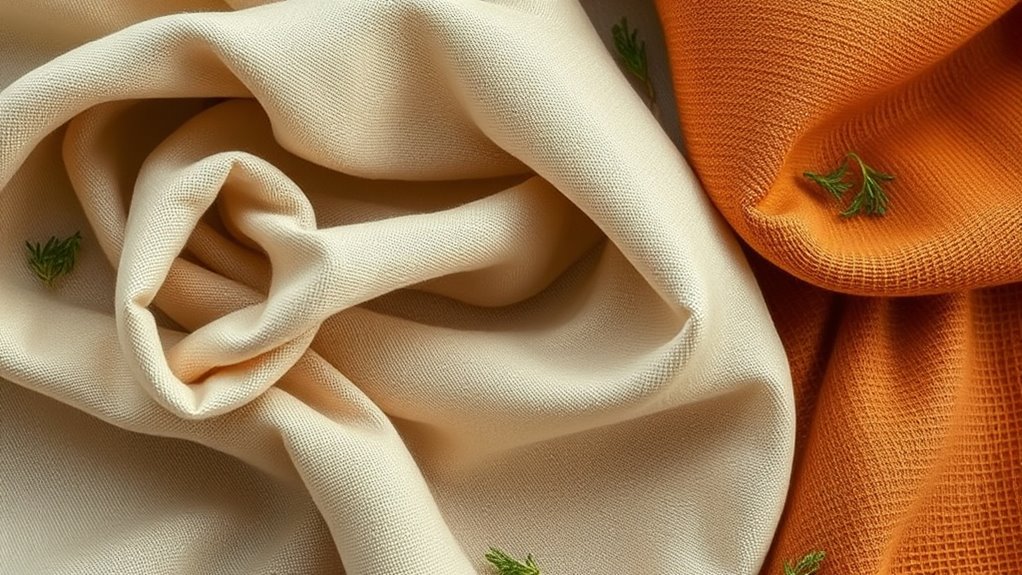
After understanding the core principles of sustainable fashion, it’s important to contemplate the materials and fabrics that align with these values. Opt for eco-friendly options like organic cotton, hemp, linen, and Tencel, which use fewer chemicals and water during production. Look for fabrics made from recycled fibers, such as recycled polyester or nylon, to reduce waste. Avoid synthetic fabrics like conventional polyester and acrylic, as they shed microplastics and are non-biodegradable. Consider the durability and lifespan of fabrics to ensure your clothing lasts longer, reducing the need for frequent replacements. Choosing natural, biodegradable materials whenever possible, and prioritize brands that disclose their sourcing and manufacturing practices. Making conscious fabric choices helps lower your environmental impact and supports sustainable fashion efforts. Additionally, AI-driven insights can assist brands in selecting sustainable materials, promoting transparency and eco-friendly innovation in eco-friendly fashion. Incorporating biodegradable fabrics into your wardrobe can further enhance your commitment to sustainability by ensuring your clothing naturally decomposes at the end of its life cycle. Recognizing the importance of innovative plant-based textiles can also lead to even more sustainable wardrobe options. Being aware of user privacy practices related to your data can help you make informed choices about the brands you support and their commitment to ethical standards.
Supporting Fair Labor and Ethical Manufacturing
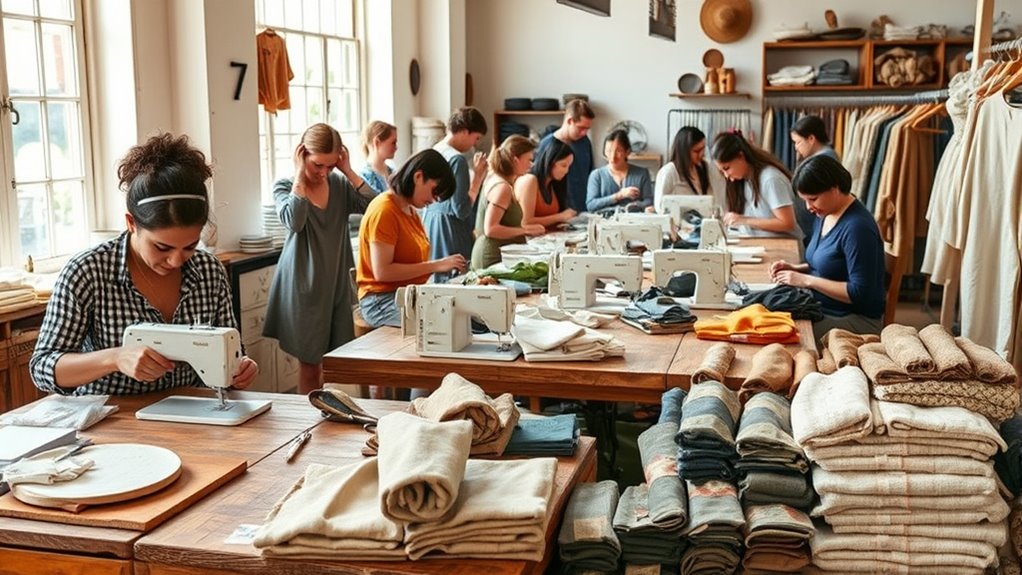
Supporting fair labor and ethical manufacturing means choosing brands that prioritize workers’ rights and transparent practices. You should look for companies that ensure fair wages, safe working conditions, and reasonable hours. Research brands’ supply chains to verify their commitments, such as certifications like Fair Trade or SA8000. By supporting these businesses, you help prevent exploitation and promote dignity for garment workers. Avoid brands that hide their manufacturing processes or show a lack of accountability. Your purchasing choices influence industry standards, encouraging others to follow suit. Ethical manufacturing isn’t just about where clothes are made, but how they’re made. When you prioritize these values, you contribute to a fairer, more sustainable fashion industry. Additionally, understanding cybersecurity best practices can protect your personal data when shopping online, ensuring your ethical choices are secure. Being aware of cookie preferences and managing your settings can further enhance your online shopping safety, giving you peace of mind. Your conscious decisions can drive meaningful change for workers worldwide.
Investing in Quality Over Quantity
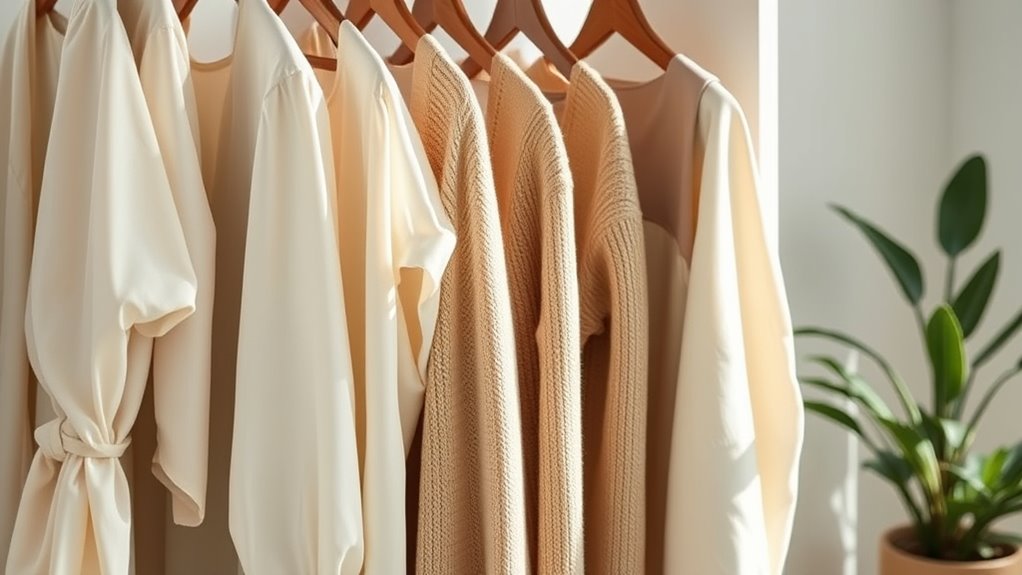
When you choose quality over quantity, your clothes become more durable and last longer, reducing waste. Ethical craftsmanship guarantees each piece is made with care and responsibility. Investing in well-made items supports sustainability and better labor practices. Additionally, supporting brands that prioritize fathers’ guidance and support fosters a more conscious and respectful fashion industry. Embracing sustainable materials further enhances the eco-friendly aspect of a thoughtful wardrobe, minimizing environmental impact and promoting responsible sourcing. Incorporating eco-friendly and safe materials ensures your wardrobe aligns with environmentally responsible practices and safe manufacturing standards. Recognizing the influence of innovative materials like Nike Tech can inspire you to choose high-performance, sustainable options. Incorporating personal development principles like mindfulness can also help cultivate a more intentional approach to fashion choices.
Durability Enhances Longevity
Choosing quality over quantity is a smart move when building a sustainable wardrobe. When you select well-made pieces, you’re investing in durability, which means your clothes last longer. High-quality fabrics and sturdy construction resist wear and tear, saving you money and reducing waste. Instead of replacing cheap items frequently, you’ll enjoy garments that maintain their shape, color, and comfort over time. This longevity encourages you to buy fewer pieces, but ones that truly serve your style and needs. Additionally, durable clothing lowers your environmental impact because fewer items end up in landfills. By prioritizing craftsmanship and materials, you create a wardrobe that’s both sustainable and timeless, helping you build a more conscious, eco-friendly fashion routine.
Ethical Craftsmanship Matters
Investing in ethically crafted clothing elevates your wardrobe beyond mere durability. When you choose pieces made with care and skill, you support artisans who prioritize quality over mass production. These garments often feature precise stitching, natural materials, and thoughtful design, ensuring they last longer and look better over time. By focusing on craftsmanship, you reduce the need for frequent replacements, which minimizes waste and environmental impact. Ethical brands prioritize transparency and fair labor practices, so your purchase contributes to a more just fashion industry. Instead of chasing fast fashion trends, you build a curated collection of timeless, well-made pieces that reflect your values. Emphasizing conscious shopping practices can inspire a sophisticated aesthetic in your personal style. Supporting sustainable materials further enhances the positive impact of your wardrobe choices. Incorporating ethical certification labels can help verify the integrity of the brands you choose. Quality craftsmanship isn’t just about appearance; it’s about making a conscious choice to invest in clothing that respects people and the planet.
Curating a Versatile and Timeless Wardrobe
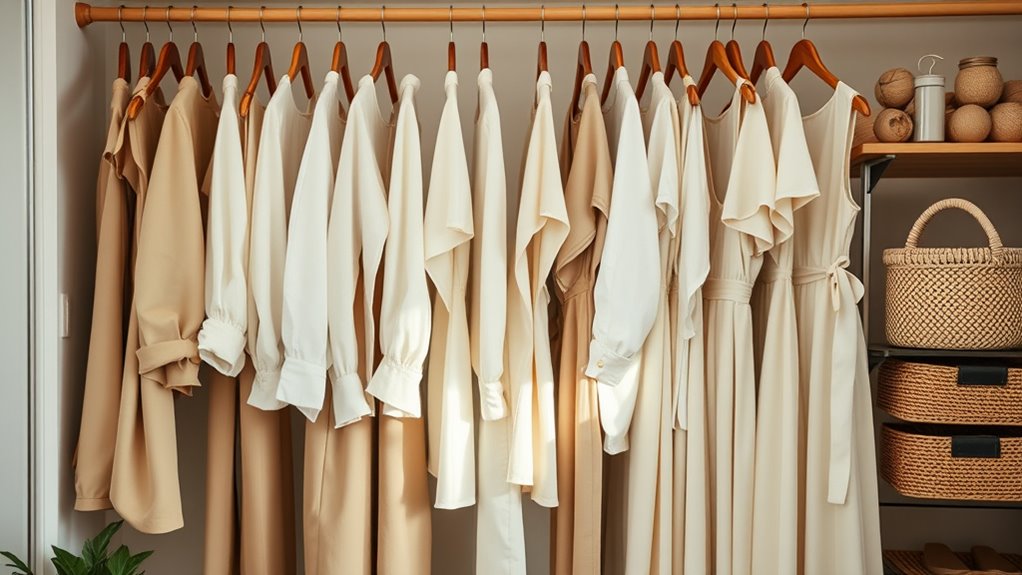
To build a versatile and timeless wardrobe, focus on mix-and-match essentials that can create multiple outfits. Invest in high-quality pieces that last longer and maintain their look over time. By choosing these foundational items, you’ll simplify your wardrobe and reduce unnecessary consumption.
Mix and Match Essentials
Creating a versatile wardrobe starts with selecting core pieces that seamlessly work together, allowing you to mix and match effortlessly. Focus on essentials that serve multiple purposes and suit various occasions. To build this foundation, consider these key items:
- Classic white shirt – pairs with jeans, skirts, or layered under sweaters.
- Neutral-colored trousers – versatile for work or casual outings.
- Timeless blazer – elevates any look and adds structure.
- Comfortable denim jeans – a go-to for casual or semi-formal settings.
These essentials form a flexible base, making it easier to create countless outfits while reducing clutter. By choosing pieces that complement each other, you craft a wardrobe that’s both sustainable and stylish, ensuring your clothing choices are intentional and long-lasting.
Invest in Quality Pieces
Choosing quality pieces is essential for building a wardrobe that lasts. When you invest in well-made garments, you guarantee durability, style, and sustainability. Quality items often use better fabrics and construction, meaning they withstand frequent wear and washing. Focus on timeless designs and neutral colors that can mix and match easily, reducing the need for excess clothing. Think of your wardrobe as a curated collection of versatile essentials. Here’s a quick glimpse:
| Item | Material | Style |
|---|---|---|
| Classic blazer | Wool blend | Tailored, versatile |
| White shirt | Organic cotton | Crisp, timeless |
| Dark jeans | Recycled denim | Slim fit |
| Leather boots | Vegetable-tanned leather | Durable, stylish |
Investing in these pieces saves money and reduces waste, aligning with your sustainable fashion goals.
Caring for Your Clothes to Extend Their Lifespan
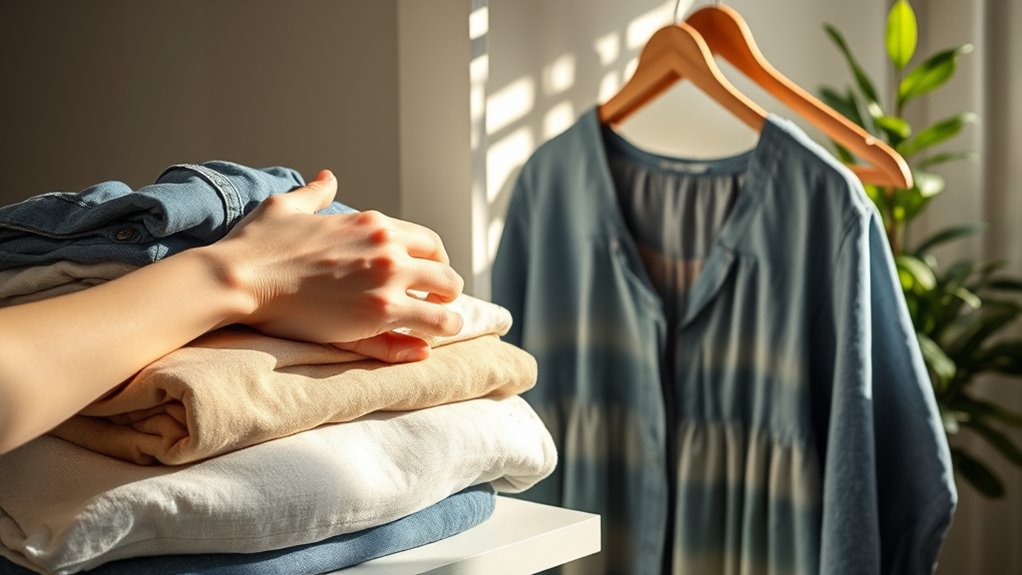
Taking good care of your clothes is essential if you want them to last longer. Proper maintenance not only saves money but also reduces waste. Here are four ways to extend their lifespan:
- Follow care labels carefully – each fabric needs specific washing and drying instructions.
- Wash clothes inside out – this protects colors and fabric surface.
- Use gentle detergents – harsh chemicals can weaken fibers over time.
- Limit washing frequency – airing out clothes can often suffice, reducing wear and tear.
Exploring Secondhand and Vintage Shopping Options
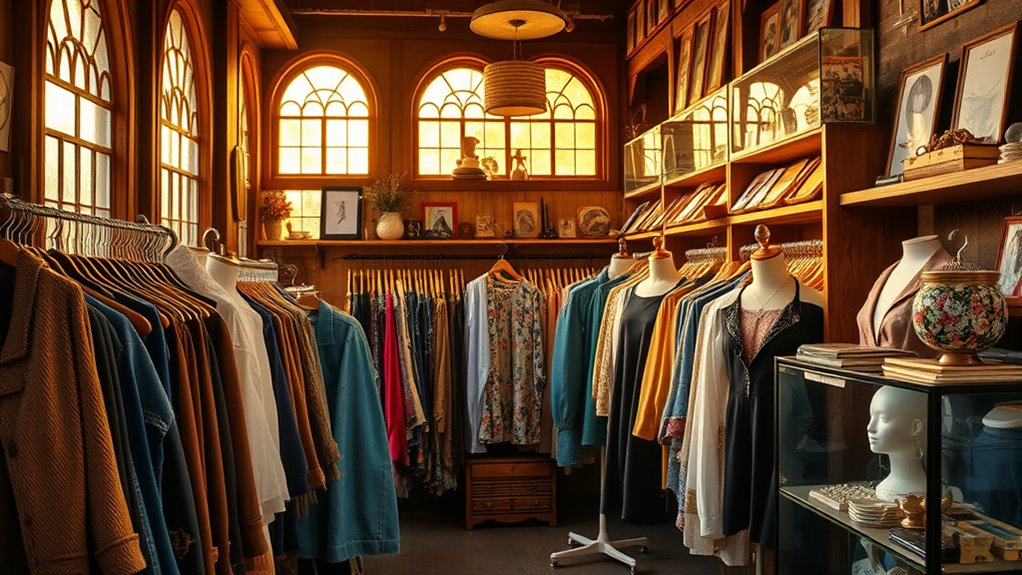
Shopping secondhand and vintage options offers a sustainable way to refresh your wardrobe while reducing environmental impact. You can find unique, high-quality pieces that reflect your style without supporting fast fashion’s harmful practices. Thrift stores, consignment shops, and online marketplaces like Depop or Poshmark make it easy to browse a wide selection of clothing at affordable prices. When shopping vintage, look for well-maintained items with minimal wear. Feel free to explore different eras for distinctive styles that stand out. Not only does this approach cut down on waste, but it also allows you to give new life to clothes that might otherwise end up in a landfill. By choosing secondhand options, you support a circular fashion economy and lessen your carbon footprint.
Incorporating Conscious Brands and Local Artisans
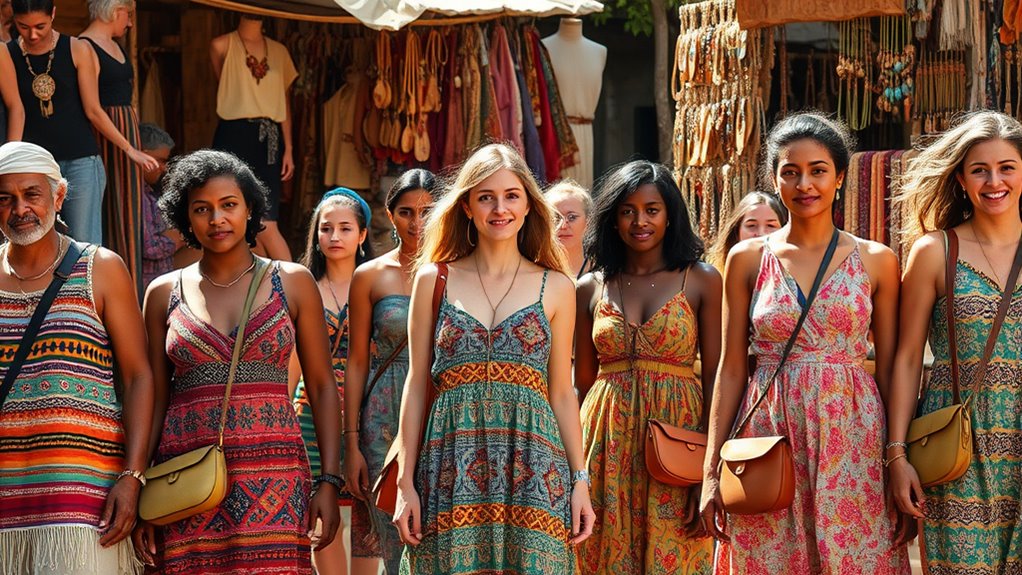
Have you considered supporting conscious brands and local artisans to make your wardrobe more sustainable? When you choose these options, you contribute to ethical practices and community growth. Here are four ways this benefits you:
Supporting local artisans and conscious brands boosts sustainability, ethics, and community growth in your wardrobe choices.
- Authenticity – Unique, handcrafted pieces reflect local culture and craftsmanship.
- Transparency – Small brands often share their sourcing and production stories, ensuring ethical standards.
- Environmental Impact – Local artisans use fewer resources and produce less waste.
- Supporting Local Economies – Your purchases help sustain small businesses and preserve traditional skills.
Frequently Asked Questions
How Can I Identify Truly Sustainable Fashion Brands?
To identify truly sustainable fashion brands, you should look for transparency about their sourcing and production processes. Check if they use eco-friendly materials and fair labor practices. Research their certifications like Fair Trade or GOTS, which indicate genuine efforts. Support brands that prioritize longevity over fast fashion, and read reviews from other consumers. By staying informed, you can make mindful choices that align with sustainable and ethical values.
What Are the Biggest Challenges in Adopting a Sustainable Wardrobe?
You might find adopting a sustainable wardrobe challenging because it requires changing shopping habits and prioritizing quality over quantity. You’ll need to research brands, understand eco-friendly materials, and sometimes pay higher prices. Balancing style preferences with ethical choices can also be tough. Additionally, it’s hard to stay consistent amid fast fashion trends. But with commitment, you can gradually build a wardrobe that aligns with your values and reduces environmental impact.
How Does Sustainability Impact the Overall Cost of Clothing?
Sustainability can initially increase the cost of clothing because eco-friendly materials and ethical production methods often cost more. However, you might save money long-term since sustainable garments tend to last longer and require fewer replacements. By investing in quality pieces, you’re reducing waste and avoiding cheap, fast-fashion items that wear out quickly. So, while the upfront price may be higher, the overall cost balances out through durability and reduced shopping frequency.
Can Sustainable Fashion Be Stylish and Trendy?
You might think sustainable fashion isn’t stylish, but that’s simply not true. Many brands now prioritize trendy, innovative designs while using eco-friendly materials. You can find chic, fashionable pieces that align with your values, proving that style and sustainability go hand-in-hand. As awareness grows, more designers blend trendiness with ethical practices, making it easier than ever for you to stay fashionable while supporting a greener future.
What Are Simple Steps to Start Building an Ethical Wardrobe?
To start building an ethical wardrobe, you can begin by evaluating what you already own and identifying pieces made from sustainable materials. Choose quality over quantity, investing in versatile items that last longer. Research brands committed to ethical practices, and prioritize secondhand shopping or clothing swaps. Keep an eye on labels for transparency, and avoid fast fashion. Small, mindful choices will gradually create a wardrobe that’s stylish, sustainable, and true to your values.
Conclusion
By embracing sustainable fashion, you’re planting seeds for a better planet and a more ethical world. Remember, Rome wasn’t built in a day, so start small—choose quality over quantity, support fair labor, and care for your clothes. Each mindful choice adds up, creating a wardrobe that reflects your values and preserves our earth’s beauty. Together, we can turn fashion into a force for good—one conscious step at a time.
